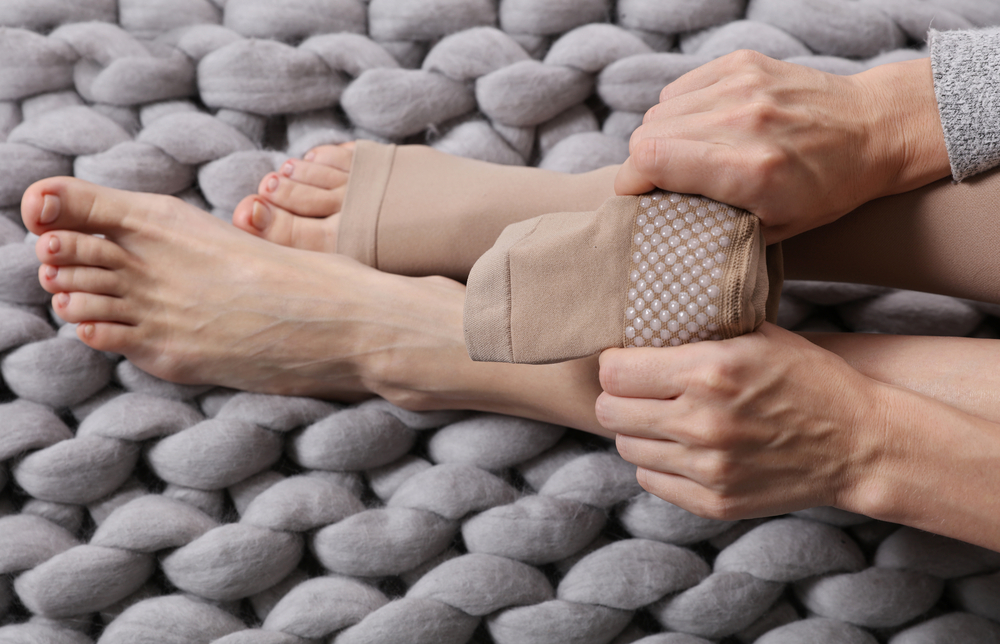How to Choose the Right Level of Compression for Your Socks
 Compression socks and stockings can offer relief for a number of issues, from generally achy legs to circulation issues and varicose veins. But if you’ve never purchased compression socks before, you might not know that there are actually different levels of compression, and each level is designed to help with different issues. If you’ve been given a prescription from a doctor for compression socks or stockings, then the prescription should specify what level of compression you need. If not, or if you’re simply looking for compression garments as a form of relief from general achiness, keep reading to learn how to choose the right level of compression for you.
Compression socks and stockings can offer relief for a number of issues, from generally achy legs to circulation issues and varicose veins. But if you’ve never purchased compression socks before, you might not know that there are actually different levels of compression, and each level is designed to help with different issues. If you’ve been given a prescription from a doctor for compression socks or stockings, then the prescription should specify what level of compression you need. If not, or if you’re simply looking for compression garments as a form of relief from general achiness, keep reading to learn how to choose the right level of compression for you.
8-15 mmHg
The level of compression in compression garments is measured in millimeters of mercury, or mmHg. But you don’t need to worry too much about exactly what that means; just know that the higher the number is, the higher the compression level.
The lowest level of compression is between 8 and 15 mmHg. It’s a good level of compression if you’re just looking for something to help with tired, achy legs. They help to gently enhance circulation in your legs to control minor swelling and generally energize the area. They’re also commonly worn by individuals with diabetes that may impact blood flow in their extremities.
15-20 mmHg
This mild level of compression is useful for minor to moderate swelling and achiness, and can also help prevent varicose veins (particularly during pregnancy). They’re also useful to wear when traveling to help prevent deep vein thrombosis, or if you tend to sit or stand in place for long periods of time during the day. They may also be prescribed by a doctor to help with Ehlers-Danlos syndrome (EDS).
20-30 mmHg
This mid-range compression level is the one most commonly prescribed by doctors, and they’re used to treat a wide variety of conditions. A few of the most common issues treated with this level of compression are varicose veins, deep vein thrombosis, moderate edema, and post-surgery. Other conditions treated with this compression level include lymphedema, May-Thurner syndrome, and orthostatic hypotension, as well as being prescribed after some surgeries. You may also see these socks marked as “firm” compression or Class I compression.
30-40 mmHg
This level of compression may also be labeled as Class II compression, and are often prescribed for more serious cases of varicose veins, severe edema, and deep vein thrombosis, as well as more serious cases of many of the conditions described in the above section. You’ll also see them prescribed post-sclerotherapy in order to help heal active venous stasis ulcers. This is a high level of compression and you should not purchase and wear these without a prescription from a doctor.
40-50 mmHg
This is the highest level of compression available from most medical supply stores. Also called Class III compression, this high of a level of compression sock should only be worn when prescribed by a doctor. A prescription for this type of compression garment is usually given to treat chronic venous insufficiency and post-thrombotic syndrome. However, it is not incredibly common for a doctor to prescribe this high of a level of compression; one of the lower levels of compression is typically sufficient in most cases.
Choosing the Right One
If you’re shopping for a compression sock without a prescription, you will likely want either the 8-15 mmHg or 15-20 mmHg compression level. This level of compression is usually sufficient to treat the most common issues like achiness, swelling, tiredness, and mild varicose veins in the legs. If you’re suffering from a more serious condition, you should consult with a doctor to discuss whether or not a compression sock may help, and what level of compression they would recommend.
If you’re still uncertain about which level of compression is right for your compression garment, feel free to reach out to one of our team members for assistance. We will discuss your particular needs and the issues you’re hoping to treat, then recommend a level of compression to help revitalize your legs and get them feeling energized and healthy once again.
Or, if we believe you’re issue requires the attention of a doctor, we’ll recommend that you get in touch with your physician to get a prescription. Once you have your prescription in hand, we will gladly help you to find a compression sock, stocking, sleeve, or other garment that properly fills your prescription. Contact one of our many Texas locations today to learn more about our stock of compression garments!